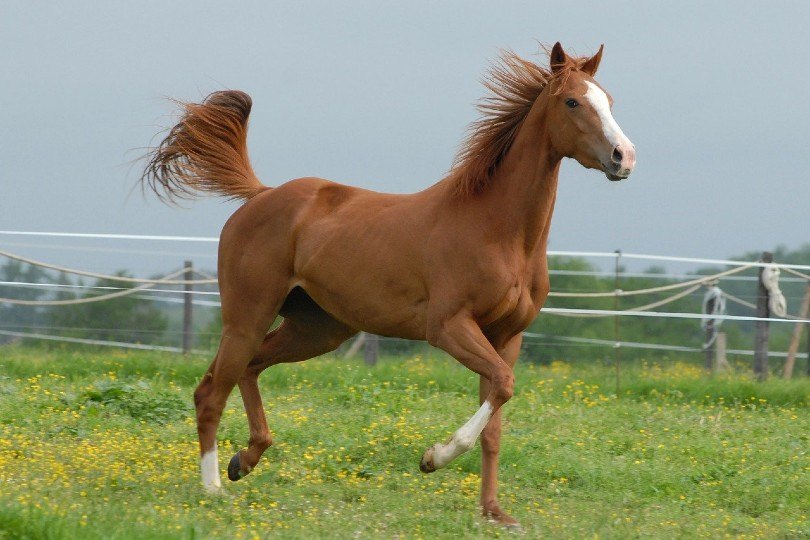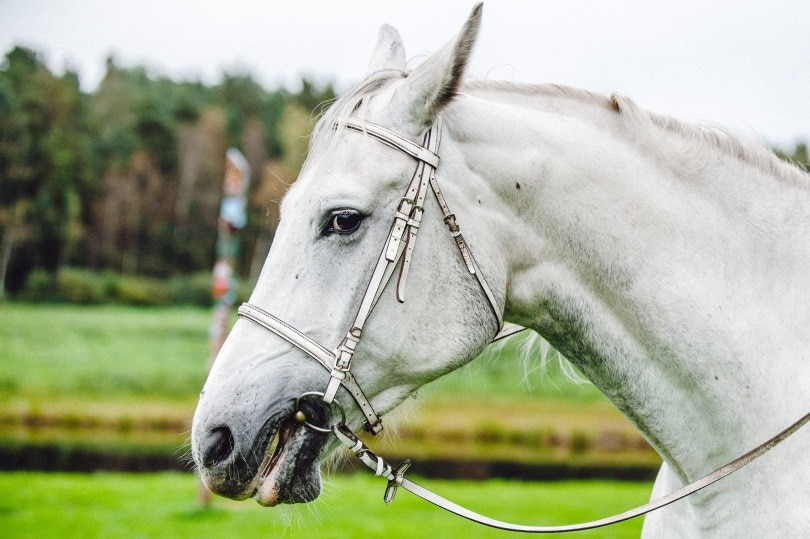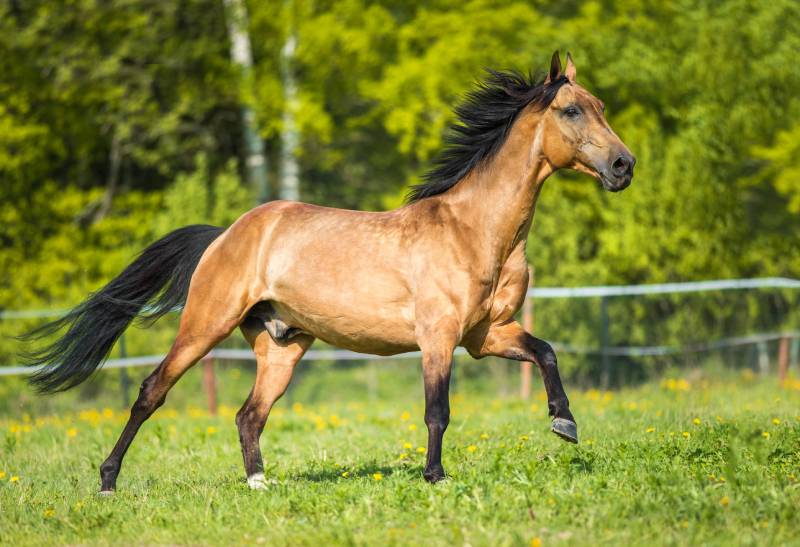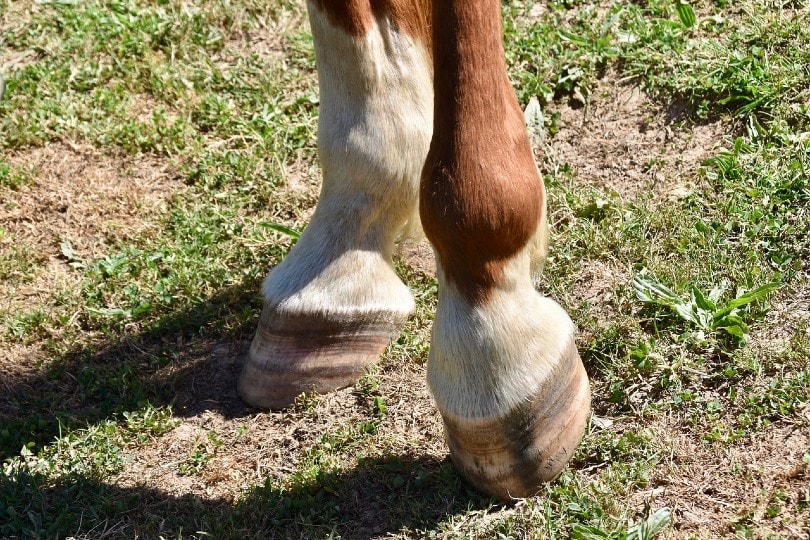
Click to Skip Ahead
To the untrained eye, horses can seem large, intimidating, and unpredictable. Nothing is more dangerous or scary than an unpredictable animal. However, while horses may seem flighty and jumpy, and unpredictable, many of them are anything but. Horses have a very large catalog of body language that will tell you exactly what they are thinking and what they are about to do. In most cases, horses are about to do two things: act normally or run away.
This article lists some of the most common types of horse body language and what it means. These tells are the important ones that let you know if your horse is relaxed or if they are anxious.
Fight or Flight
People like to tell each other that we all have a fight-or-flight response to stress. Horses are not like that. Horses are primarily flight animals. In the wild, horses are prey, and their best (and only) effective way to escape from danger is to run.
Horses can run very fast and cover long distances, something most animals cannot do. This is important to understand because this response is integral to understanding a horse’s body language. There are exceptions to this generalization. While most horses will respond to stress with a flight response, some will fight, most often stallions or horses that feel trapped.
Horses have two primary modes. A horse is usually either relaxed or thinking about running away. This can be slightly more advanced in herds of horses who are experiencing complex social dynamics. A relaxed horse will walk around, graze, stand, and sleep. A horse that is spooked is agitated, on alert, and ready to run off at a moment’s notice.
Understanding horse body language primarily comes down to this dichotomy. Looking at your horse’s features and behavior should be able to tell you if they are relaxed or in flight mode.

Ear Body Language
Ears Forward
Ears erect and facing forward is the universal sign of a bright and happy horse. If your horse is looking at you with upright ears facing in your direction, that is a good sign. This look is often accompanied by a friendly nicker or a sign that they are about to approach you.

Ears to the Side
If your horse has its ears to the side they are usually listening for something, or they are relaxed and getting sleepy. Horses’ ears follow anything they are trying to listen to so if your horse’s ears are facing outward, they are often just listening to something to the side of them. It is also important to remember that horses have much wider fields of view than humans, so they might also be watching something out of the corner of their eye.
Ears Backward
A horse whose ears are facing backward or are flat against the sides of the head is usually agitated. This can be a sign of annoyance, irritation, or anger. If your horse has this look while you are doing something, they are likely displeased with you. If your horse is doing this around other animals, such as another horse or a dog, they are often annoyed or mad about something the other animal is doing. You might want to be wary if your horse has its ears backward if you do not know exactly what is causing their irritation.
Ears Moving or Twitching
If a horse’s ears are moving around rapidly or twitching, they are usually stressed or scared. That means that your horse is on high alert. A horse whose ears are rotating around is trying to listen for danger or lock onto a sound that is scary to them. They might be spooked by a new environment, or they might have smelled something in the air that they cannot yet see or hear.

Follow a Horse’s Focus via the Ears
You can tell what your horse is focusing on by its ears. Horses do not move their heads as much as other animals to use their eyes. They primarily use their ears to listen out for potential danger. A horse can have one ear focused on you, and another ear focused somewhere else. Taking a glance at your horse’s ears can be an easy way to tell where their mind is.
Eye Body Language
Wide Eyes
Wide eyes can be a sign of fear or panic. For most horses, you cannot see the whites of their eyes when they are at rest. If your horse has widened its eyes to the point where you can see the whites around their eyes, it can be a sign that they are scared or ready to bolt.

Darting Eyes
Similar to wide eyes, darting eyes are also an indication that your horse is scared or stressed. When your horse is looking around rapidly, they are either looking for danger, like a predator, or they are looking for an escape route. A horse is often alert and looking around, but if the eyes are darting, they are looking for something.
Droopy Eyes
Droopy eyes are a sign of a sleepy or relaxed horse. A horse with droopy eyes is often ready to take a nap. Droopy eyes are usually accompanied by a yawn or two.If your horse looks like they are about to fall asleep, they usually are!
Head Body Language
Chewing
Horses can chew or lick quite frequently. Many horse owners will say that a horse licks or chews while they are thinking or processing new information. If your horse is standing there and it sounds like they are chewing on their tongue, don’t be alarmed. This is totally normal behavior that often accompanies a horse that is relaxed or experiencing something new.

Droopy Lips
Some new horse owners get concerned if they see their horse’s mouth hanging open. Sometimes the teeth will be visible, or the tongue will be hanging out of the side of the mouth. This is actually the sign of a relaxed or sleeping horse. In fact, when you sedate a horse for routine medical care, they also get this look on their face.
You don’t need to be concerned if your horse is standing and has droopy lips or an open mouth. They are often just taking a quick horse nap.
Flared Nostrils
Flared nostrils often mean that a horse is scared or stressed. A horse will flare its nostril to be able to take in more air so that they can fill their lungs if they need to bolt at a moment’s notice and to try and take in as many smells as possible. If your horse’s nostrils are flared or if they are huffing or breathing rapidly, they are likely spooked and could be preparing to take off for safer pastures.
Leg Body Language
Splayed Legs
Splayed legs can be an indication of two things. Either your horse is about to relieve themselves, or they are about to run. If you see your horse spread their back legs slightly and dig in, they might be preparing to bolt. A spooked horse can take off in a split second, and digging in is usually the first sign they are about to take off. Sometimes, a horse will splay their legs before they urinate or defecate. Knowing the difference will take some basic observation of your particular horse.

Raised Leg
A raised leg is where a horse lifts its paw off the ground and holds it there. A horse that is trying to keep its hoof off the ground is often in pain. A raised leg can be indicative of something stuck in the hoof or pain in the leg or joints. If your horse is lame and is raising its leg while at rest, you should get them checked out to ensure that nothing serious is happening in the hooves.
Cocked Leg
A cocked leg is defined as the tip of the hoof resting lightly on the ground, with the flat of the hoof being displayed roughly even with the horse’s leg. A horse with its leg cocked is often sleeping or completely at rest. It shows that a horse is relaxed and resting. Horses will only cock their legs when they feel safe and secure from threats or predators. If you see your horse cocking its leg in a stall or pasture, you know they feel at ease.
Pawing
Pawing is a behavior where horses use their front hooves to paw at the ground. Some horses can even dig sizable holes or trenches by pawing. Pawing is typically a sign of boredom. Horses that are bored will paw while tied, paw in their stall, or even paw in their trailer while being transported. It simply gives the horse something to do.
Sometimes horses will paw the ground to try and dig up some grass or to make the ground soft for laying or rolling.

Stomping
Horses will stomp when they are annoyed. Oftentimes, this annoyance is due to something simple like flies or heat. Horses will often stomp while standing, especially when tied or in a stall. Horses can also stomp if they are annoyed with something you are doing, like grooming them or trying to get them to pick their feet up. Most of the time, stomping is a simple agitated response, but it is not indicative of something more serious than a buzzing fly or minor irritation.
Laying Down
Horses lay down from time to time, and this can be a sign of numerous different things. As horses age, they will start to lie down more often, especially if they feel safe and secure in their surroundings. Laying down can be completely normal and natural behavior.
If you see your horse lying down and they get up when you approach or remain sleeping, everything is fine. However, laying down while breathing heavily, rolling around more often than usual, or lying and being unable to get up easily can be a sign that something is wrong. Horses will lie down more than normal if they are colicking or if they are having pain in their hooves.

Watch for Actions Associated With Body Language
These are general rules about horse body language, but every horse is different. One of the best ways to learn your horse’s particular behaviors or idiosyncrasies is to link up body language and action. Some horses seem to spook out of nowhere without any of the obvious signs. The truth is, the horse likely did give you a sign that you didn’t recognize at first. Some horses will give off unique body language cues before they do something like bolt, buck, or kick.
If you notice your horse doing a particular behavior before they take big action, they are likely connected. Learning your individual horse’s body language and behavioral connections can help you build a deeper and more complete understanding of your particular animal.
Conclusion
Once you start understanding the quirks and body language of horses, they become much easier to read and understand. Handling horses is all about making them feel comfortable and managing their fear. Learning and understanding their body language are important parts of this process, and these body language signs are some of the most important to know and learn for any horse.
See Also:
Featured Image Credit: jean-pierre duretz, Pixabay







